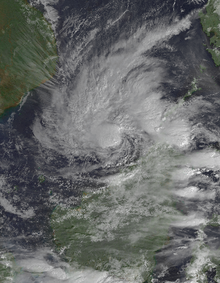 Greg at peak intensity near the island of Borneo on December 25 | |
| Meteorological history | |
|---|---|
| Formed | December 24, 1996 |
| Remnant low | December 26, 1996 |
| Dissipated | December 27, 1996 |
| Tropical storm | |
| 1-minute sustained (SSHWS/JTWC) | |
| Highest winds | 85 km/h (50 mph) |
| Lowest pressure | 1002 hPa (mbar); 29.59 inHg |
| Overall effects | |
| Fatalities | 238 total |
| Missing | 102 |
| Damage | $280 million |
| Areas affected | Malaysia, Philippines, North Sulawesi |
| IBTrACS | |
Part of the 1996 Pacific typhoon season | |
Tropical Depression Greg was a Pacific tropical cyclone that formed at an unusually low latitude in the South China Sea, and became the worst tropical cyclone to affect Malaysia since reliable records began. The last storm of the 1996 Pacific typhoon season, Greg formed on December 24 on the same two monsoon troughs that also spawned Tropical Storm Fern in the basin and cyclones Ophelia, Phil and Fergus in the Southern Hemisphere. The storm headed an east-southeastward track and despite an unfavorable environment for intensification, Greg strengthened to a tropical storm on Christmas Day. It then reached its peak intensity shortly, with maximum sustained winds of 85 km/h (55 mph) and a minimum barometric pressure of 1002 hPa before making landfall along the northern portion of the Malaysian state of Sabah between 1700 and 1800 UTC (3:00 - 4:00 am MYT) on December 26. After crossing the state, it weakened to a tropical depression before passing through Tawi-Tawi in the Philippines on the next day. Wind shear further degraded the system until it dissipated on December 27 on the Celebes Sea, south of Mindanao.
Greg was one of only two systems to made landfall in Malaysia, before Vamei in 2001 did so, nearly five years later. The storm brought extensive and catastrophic damages across Sabah, causing over $280 million in damage (1996 USD) and 238 deaths, which mainly are foreigners and tourists. Another 102 individuals were also rendered missing. Flash floods and widespread mudslides were also recorded throughout the state, destroying houses and overflowing rivers, respectively.
Following the massive aftermath of the storm, the state government of Sabah immediately started to rehabilitate the areas that sustained damages, and relief operations were speeded. The government also allocated over $2 million for the operation process, while a relief fund collected $1 million for the affected evacuees. Mass graves were also started for the unidentifiable victims of the storm. Some authorities described Greg as one of the worst disasters in the history of Malaysia.